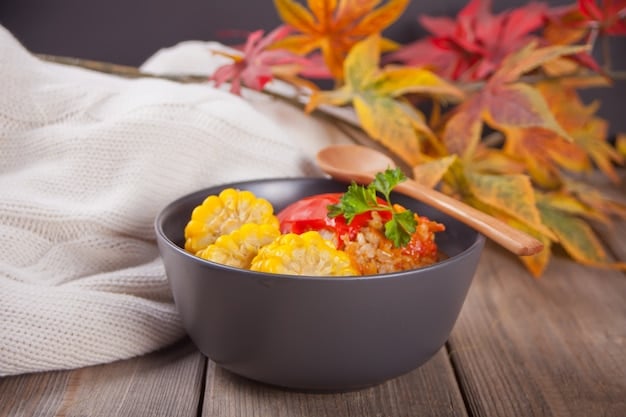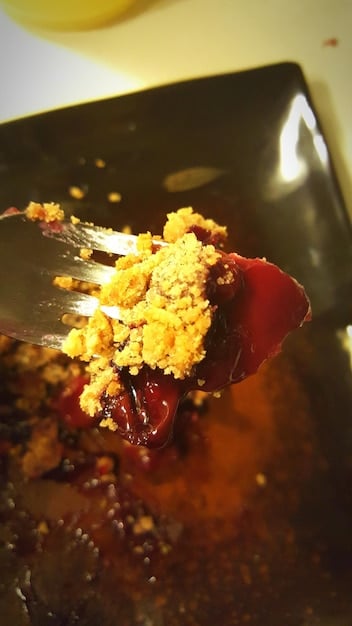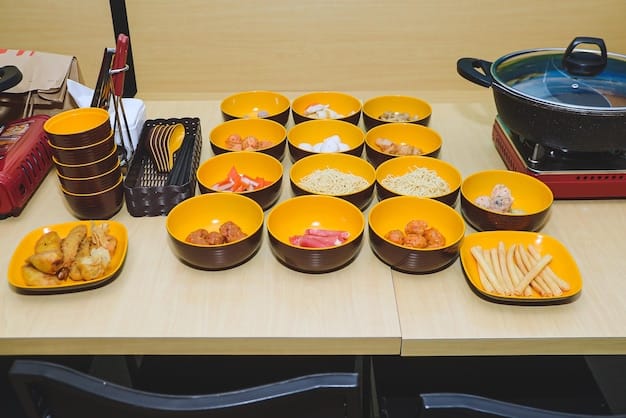Japanese Curry Uncovered: Flavors, Variations & More

Japanese Curry Uncovered: Exploring the Flavors and Variations of This Comfort Food delves into the rich history, diverse ingredients, and regional adaptations of this beloved dish, offering a comprehensive guide for enthusiasts in the US.
Embark on a culinary journey with Japanese Curry Uncovered: Exploring the Flavors and Variations of This Comfort Food, a dish that’s become a staple in households across the US. From its humble beginnings to its incredible range of flavors, discover everything you need to know about this delightful comfort food.
The Origins and Evolution of Japanese Curry
Japanese curry, or *karē raisu* as it’s known in Japan, has a fascinating history. Unlike many other Japanese dishes, curry wasn’t originally from Japan. So, how did this foreign dish become a national favorite? This section dives into its intriguing past.
From Britain to Japan: A Culinary Exchange
Curry’s journey to Japan began in the late 19th century, during the Meiji era. Japan opened its doors to Western influence, and with it came new culinary trends. The British Royal Navy, who had adopted curry from India, introduced it to Japan. Initially, it was a Western dish served in high-end restaurants and hotels.
Adapting to Local Tastes
Over time, Japanese chefs adapted the British version of curry to suit local tastes. They used ingredients readily available in Japan, such as rice, and tweaked the spice levels to be milder. This adaptation was crucial in making curry accessible and appealing to the general population.
- The Meiji era marked the beginning of Japan’s culinary exchange with the West.
- The British Royal Navy introduced curry to Japan.
- Japanese chefs adapted the recipe, creating a unique local version.
- The use of local ingredients and milder spices made curry more accessible.
By the early 20th century, curry had transformed from a foreign novelty to a beloved dish enjoyed by people from all walks of life. Its versatility and comforting flavors made it a regular feature in homes and restaurants across Japan.
Understanding the Key Ingredients
The distinctive taste of Japanese curry comes from a unique blend of ingredients. While the exact components may vary from recipe to recipe, certain elements are staples in creating that signature flavor profile. Let’s explore the essential components that make up a delicious Japanese curry.
The Curry Roux: The Heart of the Flavor
At the heart of Japanese curry lies the curry roux, a thickening agent and flavor base that defines the dish. Commercially available roux blocks are commonly used, but homemade versions offer a richer, more customized taste. These roux blocks typically contain a mix of flour, oil, curry powder, and other spices.
Common Vegetables and Meats
The most common additions include onions, carrots, and potatoes, which provide a hearty foundation. Meats like beef, pork, and chicken are frequently used, each adding a unique depth of flavor. For vegetarian options, tofu or a variety of vegetables can be substituted.

- Curry roux is the defining ingredient, available in blocks or homemade.
- Onions, carrots, and potatoes are essential vegetables.
- Beef, pork, and chicken are popular meat choices.
- Vegetarian versions often include tofu or a range of vegetables.
These core ingredients work together to create a dish that is both comforting and satisfying. Experimenting with different ingredients allows for endless variations, making Japanese curry a highly customizable meal.
Exploring Different Types of Curry Roux
The curry roux is the foundation of Japanese curry, and understanding its different varieties is key to mastering this dish. From mild to spicy, and from store-bought to homemade, the type of roux used significantly impacts the final flavor. Let’s delve into the various options available.
Commercial Roux Blocks
Commercial roux blocks are widely available in supermarkets and Asian grocery stores. These blocks come in various spice levels, ranging from mild to extra hot, catering to different preferences. Brands like S&B Golden Curry and Vermont Curry are popular choices.
Homemade Roux
For those who prefer a more customized flavor, making curry roux from scratch is an excellent option. A basic homemade roux involves browning flour in butter or oil, then adding curry powder and other spices. This method allows for precise control over the spice level and overall taste.
Choosing the right roux depends on your personal taste and the desired complexity of the dish. Commercial roux blocks offer convenience and consistency, while homemade roux provides a more tailored and authentic flavor experience.
Regional Variations of Japanese Curry
One of the fascinating aspects of Japanese curry is its regional variations. Each area of Japan has put its unique spin on the dish, incorporating local ingredients and flavors. Let’s explore some of these regional adaptations that showcase the diversity of Japanese cuisine.
Hokkaido: Soup Curry
Hokkaido, known for its rich agricultural products, offers a unique variation called soup curry. Unlike traditional curry, soup curry has a thinner, soup-like consistency and is often filled with a variety of vegetables and meats. It’s a popular dish in Sapporo, Hokkaido’s capital city.
Kanazawa: Kanazawa Curry
Kanazawa curry is characterized by its thick, dark sauce and is typically served with a bed of rice, topped with a crispy pork cutlet and shredded cabbage. This style of curry is known for its rich, savory flavor and is a local specialty.

- Hokkaido’s soup curry features a thin, soup-like consistency with abundant vegetables.
- Kanazawa curry is thick and dark, served with pork cutlet and cabbage.
- Each region uses local ingredients to create distinct flavors.
- These variations highlight the adaptability of Japanese curry.
These regional variations demonstrate how Japanese curry has been embraced and adapted throughout the country, resulting in a diverse range of flavors and styles that cater to local tastes and preferences.
Health Benefits and Nutritional Value
Beyond its delicious taste, Japanese curry also offers several health benefits and nutritional value. Depending on the ingredients used, curry can be a balanced and nutritious meal. Let’s examine some of the key health aspects of this popular dish.
Antioxidant Properties
Curry powder, a primary component of Japanese curry, contains turmeric, which is rich in curcumin, a powerful antioxidant. Antioxidants help protect the body against damage from free radicals and can reduce the risk of chronic diseases. Other spices in curry powder, such as cumin, coriander, and ginger, also offer antioxidant benefits.
Nutrient-Rich Ingredients
The vegetables commonly used in Japanese curry, such as carrots, potatoes, and onions, provide essential vitamins and minerals. Carrots are a good source of vitamin A, which is important for vision and immune function, while potatoes offer potassium and vitamin C. Onions are rich in antioxidants and can help reduce inflammation.
While Japanese curry can be a healthy meal, it’s important to be mindful of the ingredients and portion sizes. Choosing lean meats or plant-based proteins and loading up on vegetables can further enhance its nutritional value.
Tips for Making the Perfect Japanese Curry at Home
Creating delicious Japanese curry at home is easier than you might think. With a few simple tips and tricks, you can achieve a flavorful and satisfying meal. This section provides essential guidance for making the perfect Japanese curry in your own kitchen.
Choosing the Right Roux
Selecting the right curry roux is crucial for achieving the desired flavor. Consider your spice preference and choose a roux that matches your taste. If you’re unsure, start with a mild or medium spice level and adjust accordingly. Experimenting with different brands and types of roux can also help you discover your favorite.
Sautéing the Vegetables
Sautéing the vegetables before adding the liquid and roux helps to develop their flavors. Cook the onions until they are translucent and slightly caramelized, which will add a subtle sweetness to the curry. Add the carrots and potatoes and cook until they are slightly softened.
- Choose a curry roux that matches your spice preference.
- Sauté the vegetables to develop their flavors.
- Simmer the curry for at least 30 minutes to allow the flavors to meld.
- Adjust the consistency by adding water or broth as needed.
By following these tips, you can create a delicious and authentic Japanese curry that rivals your favorite restaurant version. Don’t be afraid to experiment with different ingredients and techniques to find your perfect recipe.
| Key Point | Brief Description |
|---|---|
| 🍛 Origins | Introduced by the British Royal Navy and adapted by Japanese chefs. |
| 🌶️ Curry Roux | The heart of the flavor, available in commercial blocks or homemade. |
| 🇯🇵 Regional Variations | Includes Hokkaido soup curry and Kanazawa curry. |
| 🌱 Health Benefits | Rich in antioxidants and essential nutrients. |
Frequently Asked Questions
▼
Japanese curry is a popular dish made with curry roux, vegetables, and meat. It is typically served with rice and is known for its mild to moderately spicy flavor.
▼
The main ingredients include curry roux, onions, carrots, potatoes, and a protein source like beef, pork, chicken, or tofu. These combine to create a hearty and flavorful meal.
▼
Japanese curry can range from mild to very spicy, depending on the type of curry roux used. Most commercial roux blocks offer different spice levels to suit various preferences.
▼
Yes, Japanese curry can easily be made vegetarian by substituting the meat with tofu, lentils, or a variety of other vegetables. This versatility makes it a favorite for many.
▼
Popular toppings include tonkatsu (pork cutlet), chicken katsu, fried eggs, and pickled vegetables like fukujinzuke or rakkyo. These additions enhance the overall flavor and experience.
Conclusion
In conclusion, Japanese Curry Uncovered: Exploring the Flavors and Variations of This Comfort Food offers a delightful culinary adventure, blending rich history with diverse flavors. Whether you’re a seasoned chef or a beginner, mastering Japanese curry is an enjoyable way to bring a comforting and nutritious dish to your table.





